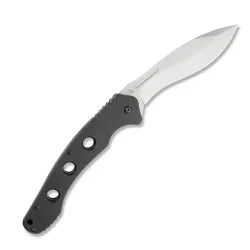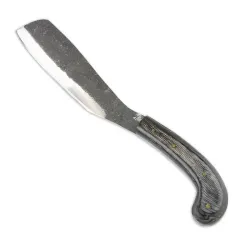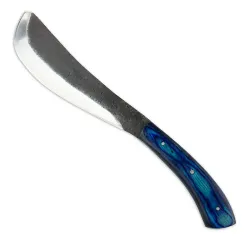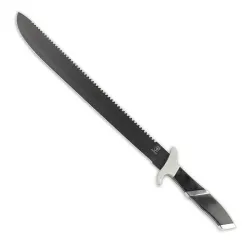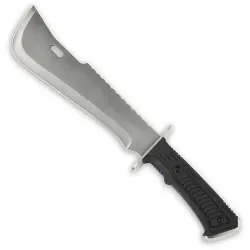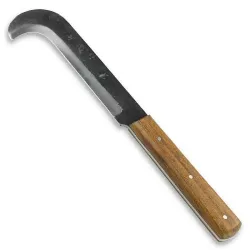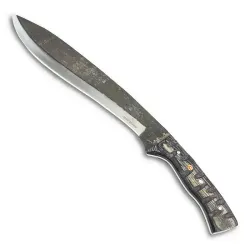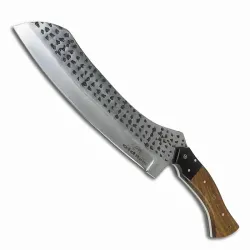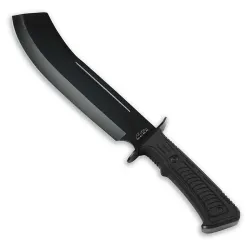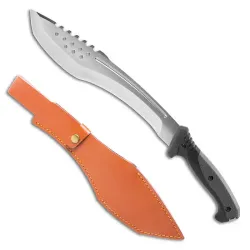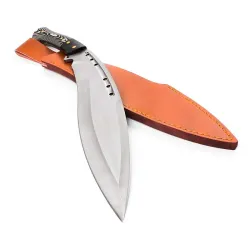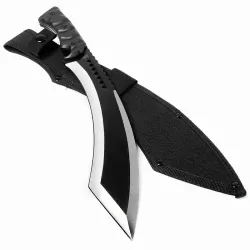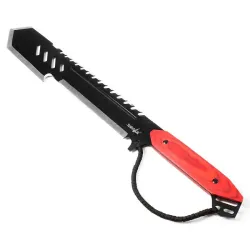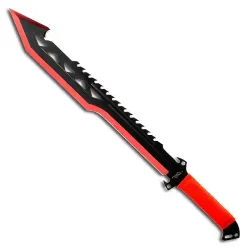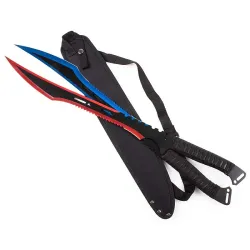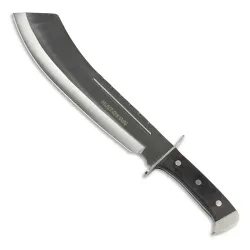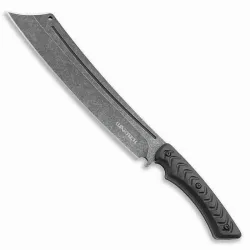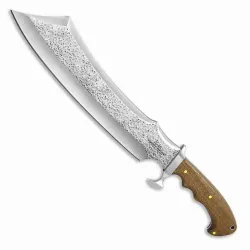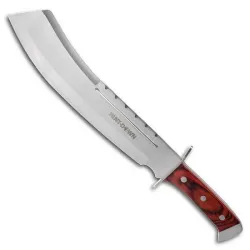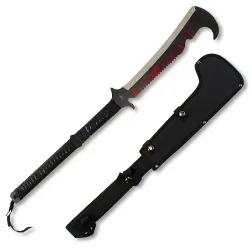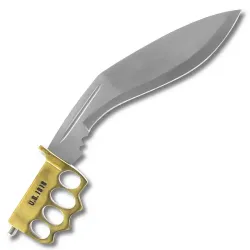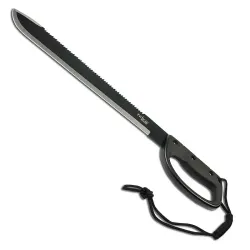Machetes, Kukri Knives, Parangs & Panga Blades
-
$42.95
-
$44.95
-
$44.95
-
$44.95
-
$34.95
-
$29.95
-
$44.95
-
$32.95
-
$49.95
-
$42.95
-
$32.95
-
$29.95
-
$64.95
-
$64.95
-
$49.95
-
$32.95
-
$59.95
-
$69.95
-
$34.95
-
$34.95
-
$34.95
-
$99.95
-
$119.95
-
$43.95
-
$44.95
-
$54.95
-
$39.95
-
$82.95
-
$39.95
-
$52.95
-
$69.95
-
$36.95
The machete is one of the most versatile tools ever created. Farmers, explorers, and soldiers alike have relied on machetes for everything from chopping down vegetation to splitting coconuts. Different cultures around the world shaped their own versions, each designed for the environment they were used in. A classic example is the panga, a machete style from Africa with a heavy, forward-curved blade that makes quick work of thick brush and tall grass. In Southeast Asia, the parang became the go-to tool for cutting paths through dense jungle. Its slightly curved design delivers smooth, controlled slices that make it excellent for both utility work and combat. Even the Japanese have their own variation known as the nata machete, originally used in gardening and forestry but equally handy as a survival tool.
There's also the sawback machete, which adds teeth along the spine of the blade so you can use it as a makeshift saw when you don't have the right gear with you. Survival machetes take this concept even further, often including features like serrations, coated blades for rust resistance, or heavy-duty grips that hold up in wet conditions. Billhook machetes, with their hooked blade design, are a traditional European tool that has been used for pruning vines and cutting branches, but many survivalists today value them for their ability to grab and pull vegetation while chopping. Then you've got the straight-up combat machete, built with fighting in mind and designed for durability and balance rather than just clearing a trail. Each style of machete brings its own strengths, which is why they've become such a staple in both rural communities and modern survival kits.
Of course, you can't talk about this category without highlighting the kukri. The kukri knife is one of the most recognizable blades in the world thanks to its iconic inward curve. Originating in Nepal, the kukri has been the traditional weapon and utility tool of the Gurkhas, legendary soldiers known for their toughness and skill. A kukri knife is not just a weapon but also a daily tool used for chopping wood, preparing food, and general farm work. The unique shape places more weight toward the front of the blade, which means the kukri delivers a chopping force far beyond its size. Kukri knives come in different sizes, from compact blades for utility tasks to full-sized weapons that can take down saplings in a single swing.
Modern kukri knives have found a place in the survival and bushcraft community. Their curved edge makes them just as effective at carving and slicing as they are at heavy chopping. Some designs stick close to the traditional hand-forged look with wooden or horn handles, while others use modern materials like micarta or rubber grips to provide extra control in rough conditions. Whether you're using a kukri as part of your camping gear, displaying one as a piece of history, or carrying it as a reliable tool for emergencies, it's easy to see why the kukri remains so popular.
The parang traces its roots to Southeast Asia, particularly Malaysia and Indonesia, where dense rainforest demanded a tool that could chop through vines and bamboo yet remain nimble for precise cutting. Unlike a straight machete, the parang's blade is thicker and shorter, designed to resist bending when tackling tough wood. Many traditional parangs also feature a slightly angled edge that makes slicing motions more efficient, almost like combining an axe and a knife into one. Hunters and villagers carried them daily, using them to build shelters, prepare food, and fend off predators.
The panga, on the other hand, developed in Africa where farmers needed a wide-tipped blade to chop sugarcane, corn stalks, and thick brush. That flared tip shifts the weight forward, turning every swing into a powerhouse chop. Pangas became so important to rural communities that they're still found in nearly every African household today, often passed down through generations. Over time, the design spread beyond farming into military use, valued for the same reason it thrived in agriculture: sheer cutting force. When you set a parang next to a panga, you can see how geography shaped the blade: the jungle demanded precision and durability, while the savanna rewarded brute chopping strength.
Whether you're looking at the thick jungle-ready parang, the heavy chopping power of a panga, or the battle-tested history of a kukri knife, these blades have stood the test of time because they work. Each design reflects the culture and environment it came from, giving you a glimpse into how people around the world solved the same problem in different ways: building a tool tough enough to handle real work in the outdoors.
What Is the Difference Between a Machete and a Kukri Knife?
A machete typically has a longer, flatter blade that excels at sweeping cuts through brush, vines, and light wood. It shines in trail clearing and vegetation control where reach and slicing speed matter. A kukri knife has a distinctive inward curve and more weight toward the front, which turns short swings into heavy chops. That geometry lets a kukri bite deep for tasks closer to an axe, like limbing small branches, splitting kindling, and general camp work. In short, machetes favor reach and slicing across lighter material, while kukri knives concentrate power for controlled chopping and versatile utility in tighter spaces.
What Is a Parang Used For Compared to Other Machetes?
The parang comes from Malaysia and Indonesia, where it was designed for life in the rainforest. Its blade is usually shorter and thicker than most machetes, with a gentle curve that helps it glide through bamboo, vines, and dense jungle vegetation. The extra thickness keeps it from flexing or chipping when tackling hardwoods. Compared to a lighter, straight-bladed machete, the parang is slower but far more durable, making it a favorite for bushcraft, carving, and building shelters. It bridges the gap between knife and axe, offering precise control for fine tasks and enough heft for heavy chopping when needed.
What Makes a Panga Machete Different From a Parang?
The panga machete developed in Africa, where farmers needed a blade with raw chopping power for sugarcane, corn stalks, and thick brush. Its wide, flared tip shifts the balance forward, so each swing lands with extra force, almost like a small axe. The parang, by contrast, is slimmer, thicker, and more evenly balanced, designed in Southeast Asia for cutting through jungle vegetation with controlled strokes. While the parang excels at versatility and precision, the panga is all about power and efficiency on heavy vegetation. Side by side, the panga favors brute strength, while the parang is built for endurance and accuracy in dense forest environments.
Can a Kukri Replace a Hatchet or Axe?
A kukri can handle many of the same jobs as a hatchet or small axe, but with a different feel. The forward-curved blade puts a lot of weight at the front, so even a short swing drives deep into wood. That makes it surprisingly effective for splitting kindling, chopping branches, or clearing brush. Where it differs is in reach and leverage: a full-sized axe delivers more power for felling large trees, while a kukri trades some of that raw force for precision and versatility. For camping and survival, a kukri can absolutely stand in for a hatchet since it also doubles as a knife for carving, food prep, and finer tasks.
What Is the Best Machete Style for Clearing Thick Brush?
For cutting through heavy vegetation, the best machete style depends on the terrain, but a few stand out. The panga machete is excellent for thick brush because its flared tip adds weight that powers through dense stalks and branches. The parang also works well in this role, especially in jungle-like conditions where its shorter, thicker blade resists bending and keeps cutting cleanly through tough vines and hardwood. A standard Latin machete with a long, straight blade is another solid choice if you need reach and speed in overgrown areas. Each design works, but if raw chopping power is the goal, a panga usually comes out on top.
How Do I Sharpen a Machete or Kukri Knife?
Sharpening a machete or kukri knife is about balancing durability with cutting performance. Most machetes are kept with a working edge rather than a razor edge, since they're meant to chop through wood, vines, and brush. A good method is to use a sharpening stone, file, or even a puck-style sharpener, maintaining the factory angle, which is often around 20-25 degrees. Work evenly on both sides and finish with a strop or fine stone if you want a smoother edge. For kukri knives, focus on the curved belly since that's where most chopping happens. Keep your strokes consistent and avoid grinding away too much steel, as the blade's weight and geometry do most of the cutting. Regular touch-ups in the field are better than waiting until the edge gets completely dull.
Are Kukri Knives Still Used by the Gurkhas Today?
Yes, kukri knives are still carried by Gurkha soldiers as part of their traditional kit. While modern firearms and gear have taken center stage in combat, the kukri remains a symbol of the Gurkhas' history and reputation. It's not just ceremonial either. Many Gurkhas continue to train with the kukri, and it can still be used in the field for practical tasks like clearing brush, cutting firewood, or close-quarters fighting if needed. Beyond the military, the kukri has become a national symbol of Nepal, representing both the strength of its soldiers and the everyday utility of the blade in rural life.
What's the History Behind the Kukri Knife?
The kukri knife has a history that stretches back hundreds of years in Nepal, where it became both a daily tool and a weapon of war. Its exact origins are debated, but many historians trace its design to early blades used in South Asia and the Indian subcontinent. What makes the kukri stand out is its curved profile, which allowed Nepalese farmers to use it for chopping wood, harvesting crops, and preparing food, while also making it a formidable weapon when called upon. The blade gained worldwide fame in the 19th century when Gurkha soldiers, armed with kukri knives, earned a reputation for bravery and effectiveness in battle. Since then, the kukri has become a cultural symbol of Nepal, representing both utility and martial tradition. Today it remains one of the most iconic blades in the world, admired for its history, functionality, and unique design.
What's the Most Versatile Type of Machete?
If you want one machete that can handle just about everything, the Latin machete is usually considered the most versatile. Its long, straight blade makes it great for clearing grass, vines, and light brush, while still being light enough for quick swings and extended use. Unlike specialized blades like the panga or billhook, the Latin machete doesn't lean heavily toward one task, so it adapts well to a wide range of situations. That said, versatility can also depend on where you are. In thick jungle, a parang might be more effective, while in farmland, a panga could outperform other styles. For general outdoor use and survival, though, the Latin machete is often the go-to choice because it balances reach, speed, and cutting power in a single design.
Can a Machete Be Used for Self Defense?
A machete can be used to defend yourself in an extreme situation, but it is not an ideal or recommended self-defense tool for most people. These blades are designed for cutting and chopping, not for controlled defensive use. They are long, heavy at the tip, and can be awkward to handle in tight spaces. That makes them effective at creating distance or delivering powerful strikes, but also makes them harder to control safely under stress. If you are carrying a machete for outdoor work and an unexpected threat appears, it may be usable, but relying on a machete as your primary self-defense plan brings serious risks.
Laws about carrying and using large blades vary widely by state and country, and using a machete in a confrontation can quickly lead to criminal charges or civil liability even if you felt threatened. Before deciding to carry any large knife, check local laws about carrying edged tools in public, open carry rules, and self-defense statutes. In many places, a defensive action that injures someone can be judged against what a reasonable person would do in the same situation. That means a nonlethal option like pepper spray, a loud whistle, or learning de-escalation and avoidance techniques is often a safer and legally cleaner choice.
If you already use a machete for work or camping, focus on safe handling, secure storage, and proper transport so it is available when needed without putting you or others at risk. Get basic training in safe blade handling and first aid rather than combat techniques. The most reliable form of self defense is situational awareness, escape, and calling for help. A machete is a tool first, and a last-resort defensive option at best.
What's the Difference Between a Billhook Machete and a Sawback Machete?
A billhook is an old European tool with a hooked tip designed for pruning, cutting vines, and grabbing branches as you slice. That hook lets you pull and control what you are cutting so you can make efficient, close-in cuts without the material slipping. Billhooks are great for hedge work, coppicing, and agricultural tasks where you need to both cut and manipulate vegetation. They tend to have stout blades and a utility-focused profile that favors control over long reach.
A sawback machete adds teeth along the spine so it doubles as a saw when you need to cut small branches or notch wood and you do not have a separate saw handy. The sawback is handy in survival and trail situations because it gives you two cutting tools in one package: a chopping or slicing edge plus a rough saw. The trade off is that the saw teeth can catch or snag on clothing and vegetation, and they add a little weight toward the spine.
In practical terms pick a billhook if you do a lot of pruning, vine work, or tasks that benefit from the hooked tip and greater control. Pick a sawback if you want a multi tool for camping, trail clearing, or emergency use where the ability to saw small limbs could save you time and gear. Both are workhorse designs but they solve different problems: the billhook is about controlled cutting and pulling, the sawback is about adding a cutting option when splitting or trimming wood.

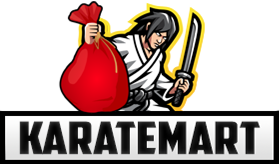


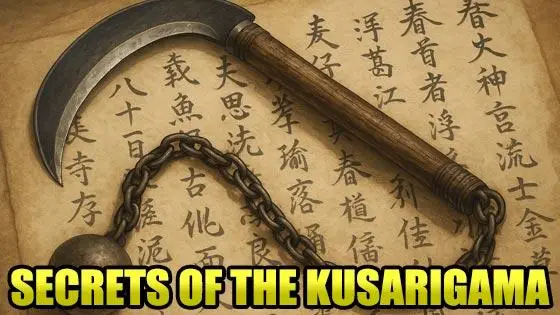

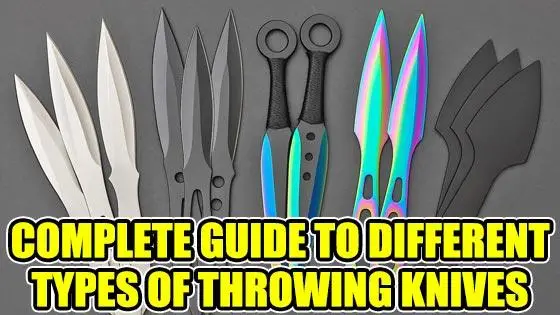

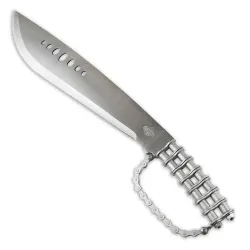


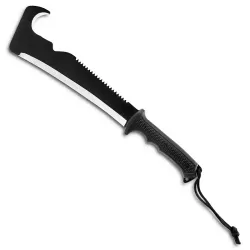
 (1)
(1)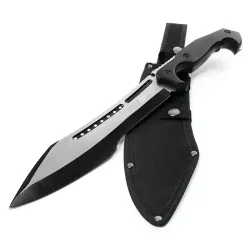
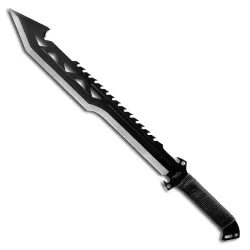

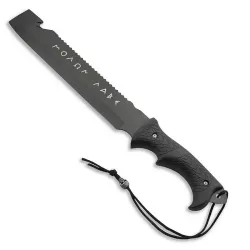
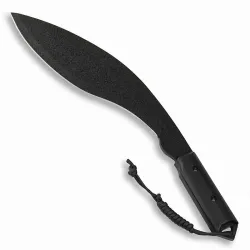
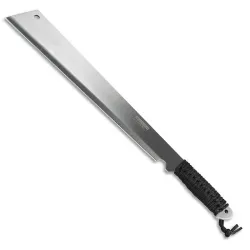
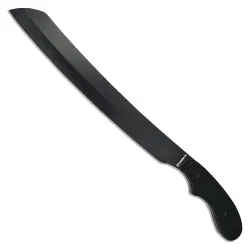
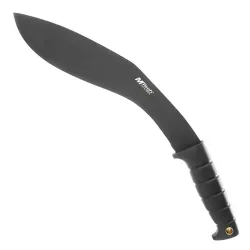
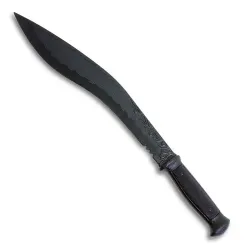
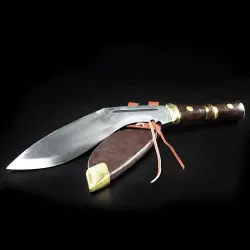
 (2)
(2)